Settling in at St Albans
Settling in at St Albans
By Ian Smith
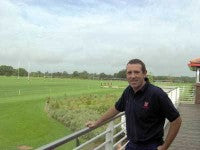
Doesn't time fly when you are busy. It has been over three years since the new school playing fields were constructed back in 2002. And what a difference they have made to the school's reputation. The growth and interest in sport participation has doubled. With well over 700 pupils regularly using the new facilities.
History
St Albans is one of the oldest schools in the UK, being in existence since 948 AD, well over 1000 years. From 1947 the principal area for team sports had been the King Harry playing fields, originally leased from Lord Verulam, a descendant of Sir Nicholas Bacon. This was not large enough for the growing school roll so the school needed to relocate. The school had previously sold off Belmont Hill field a small ground on the flood plain of the river Ver and put the money put into a trust fund for freehold land for sport, enabling them the opportunity to purchase the 400 acre Cheapside Farm, situated just to the north of the city in 1991. Part of this site was developed to create the Woollam Playing Fields, to provide 73-acre outdoor sports facility for the School and the Old Albanian Club. HRH the Duke of Gloucester officially opened the playing fields in October 2002.
The school still farm the rest of the farm site (327 acres) and have signed up to the countryside stewardship scheme improving many things for wildlife, putting in field margins, replanting an old orchard as well as planting a new wood.
The school allows access to other schools by using the old land army girls bunkhouse from WW2 as a classroom for field studies. New access for the general public has been allowed with the installation of a public footpath through ancient woodland.
I consider myself very privileged to have been involved since the start of the project back in 1991, it took three public inquiries over nine years, it was very interesting to be involved at this level and then to be part of the design team. Rob Everett from the STRI was employed to draw up the specification and Guy Shatford oversaw the work. It was, at the time, one of the biggest sports field constructions ever to be undertaken in the UK with a estimated value of 10 millions pounds.
White Horse Contractors successfully won the tender to carry out the construction of 19 football/ rugby pitches and 7 cricket tables, one full size artificial all weather facility and 9 tennis courts. Two sports pavilions were constructed one for the school and the other for the Old Albanians club.
The construction of the playing fields took over two years; firstly all the topsoil on the site was removed, screened and stored. All stone material was reused in some parts of the constructions. The soil on the site is a heavy clay soil, which dictated that our primary drainage for the site was installed at 4 m centers.
The construction of the cricket tables was consistent. All the squares were constructed over a 150mm gravel raft, having a 300mm depth of soil placed over them consisting of 150mm of the native clay soil and topped over with 150mm of Boughton loam (28% clay loam), which in fact was near on identical to the native soil.
The tables were then sown with Perennial rye grass mixtures containing BSH Aberimp and Aberelf.
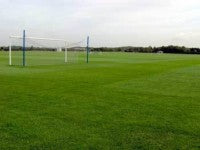
Having a predominate clay soil on our pitches certainly helps the sward. The clay soil retains plenty of moisture during dry conditions handy when you do not have a good irrigation system.
During the final phases of construction in September 2001 we had some torrential rain that delayed some phases of construction, particularly some of the cricket squares that had to remain open to the elements. On reflection, it did however help them settle down. All our cricket wickets have since performed very well.
I originally had 6 staff including myself but that has recently been reduced down to five when one took up an opportunity to work elsewhere.
Our workload at the school is always manic especially in the summer months when we have all the cricket squares up and running, with over 85 wickets being used during the summer term. We have to keep on top of the grass cutting/ mowing of over 73 acres of grass between 2-3 times per week.
Our year is broken into three main terms, summer, autumn and winter.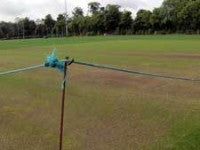
- Cricket and summer sports are played from May-July.
- Rugby September-December.
- Football January-May.
The site is split into two main site areas the School site and the Old Albanian sport association
The school facilities consist of the following: -
- 6 Rugby pitches.
- 4 Football /2 small sided pitches.
- 5 cricket tables/3 separate synthetic match pitches/3 blocks of nets.
- 4 Tarmac Tennis courts.
- 1 full size sand filled artificial pitch/9 tennis courts.
780 pupils have access to these facilities on a daily basis; the Schools two storey sports pavilion has 18 changing rooms to accommodate the needs of the pupils.
The Old Albanians site consists of the following: -
- 6 Rugby pitches.
- 2 cricket tables/nets.
- 4 Artificial sand filled tennis courts.
The Old Albanians has a clubhouse with two bars meeting rooms health club and eight changing rooms.

The rugby club since taking over these new facilities has grown in popularity. Originally the club only ever ran four senior sides. These days it runs six adult teams along with a new youth academy team and two women's teams the OA Saints. Saracens A team also use us for all there fixtures, plus representative Herts all ages, England Women and England schoolboys etc.
We now also have rugby 12 months of the year as St Albans Centurians rugby league side have brought there two sides here, we sometimes have both rugby codes on the same pitch on the same day, we used to have to change markings over but after a heated discussion with a rugby league ref who gave us only 20 mins to green out union lines and mark league in white we now mark one in blue and other in white and they just have to get on with it. It looks like the floor of a sports hall
The pitches are in constant demand seven days a week.
On weekends over 500 kids utilise the club and train and play on the pitches, this year we now have to accommodate additional pitches on the cricket pitch outfields.
Because the pitches here at St Albans are maintained to such a high level there's no wonder there been an increase in usage. Which of course is great, seeing a growth in sporting activity.
The Old Albanians training pitch, being floodlit now, has well over 20 hours use a week alone, which over time has begun to tell. Even now only three weeks into the new rugby season we are seeing significant wear and tear.
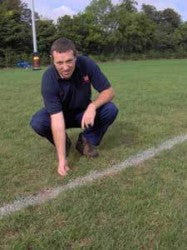
|

|
Having witnessed the amount of use this particular pitch gets I felt it necessary to try and improve the sward. Having recently read about the benefits of using tall fescue (Festuca arundinacea) grasses. I decided that it would be an opportunity to see for my self what we could achieve.
In May I managed to sow 12 (25kg) bags of tall fescue into the whole pitch, the results have been encouraging especially as they began using the pitch in July. This grass does take time to establish, however we have been pleased with its performance. And we hope that it will help slow down the wear we experience on this pitch, although I still think by the end of the season the pitch will be devoid of grass, maybe a 3G pitch is the way to go with this amount of wear.
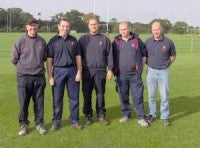
Chris is our trained mechanic and doubles up as a Groundsman; he looks after and services all our machines and other equipment.
We purchase and buy all our own machinery, we do not like to get into leasing situations where you can be tied into a single companies brand of machinery.
We had the opportunity to trial most of the machinery on the market and after a period of time were able to decide on the machines that best suited our needs.
I think we have most aspects covered. My current main concern is not having enough staff to man them.
I have been very pleased in the way the pitches have settled down and matured. With three growing seasons under our belt the sward on our pitches is excellent. In fact we have very little Poa annua grasses currently growing on any of our pitches. Which in turn has meant that we rarely suffer divots during games.
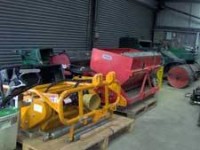
|
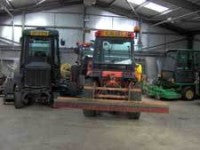
|
Maintenance regimes
With such large areas of grass to mow on such a regular frequency we have chosen to mow our outfields using ride on Hayter fairway mowers and we let the clippings fly As soon as we have finished cutting the site we start again . We do have a couple of 36-inch Allett mowers that we can use for presentation purposes, however time is very precious so we need to be efficient in our mowing regimes.
We maintain a height of 25mm all the year round on football pitches. Cricket outfields are kept at 12mm in the summer and 17mm in the winter.
The rugby Pitches are maintained using the Amazon mower, cutting and collecting the clippings, maintaining a cutting height of 75mm.
I tend to treat the whole site the same in respect to the run of the mill maintenance operations, cutting, feeding and aerating because the whole site has been uniformly constructed.
We brush the pitches to remove dew prior to mowing if we have time, we apply about five feeds a year, and then tailor some areas depending on how they are performing and soil analysis or their needs at the time. Aeration is carried out when conditions are favourable using our vertidrain machine.
We mark all our pitches on average once a week plus for all fixtures ; we use a combination of dimple/wheel transfer and Kombi spray jet markers. It usually takes about twenty five minutes to over mark each pitch with Kombi. However we generally use lines when marking the first team pitches with dimple. (but have you seen the new Kombi lazer,we over marked rugby in 30mins perfectly straight).
We have three Kombi's and three Dimple markers, of which one is kept for blue line marking required for Rugby league.
We over mark nine tennis courts on the all weather area and found by using the Kombi with Pitchmarker Super C marking fluid, we have saved on time and money compared to using aerosols.
Our All weather pitch is brushed and swept weekly and we keep all the equipment for these operations in a shed near to the pitch, preventing ingress / contamination from mud and grass arisings being transported in.
With the cricket term finishing in July, we are able to get onto our renovations in early August, making best use of the favourable weather conditions to repair 66 school wickets. OA cricket renovations are done in Sept . Our renovations this season, consisted of scarifying in three directions using the SISIS rear mounted Rotorake TM1000 set at 3mm, with the squares being relatively young and the fact that they are regularly verticut we do not yet suffer from too much thatch.
I have been pleased with how well the squares have performed, considering how young they are we do have well over 150mm of root growth, which is encouraging. We did have a small root break problem last year, and this was probably due to the fact we aerated too soon last autumn. Ideally you need to wait until there's enough moisture in the soil profile to prevent any pulling which caused the rootbreak. However I am confident the squares will be fine for next year.
We top dressed using Boughton loam applying about 8 x 25kg bags per strip and overseeded with British Seed Houses rye grass mix, Aberimp and Aberelf. We also completed the same work on all our practise net areas.
With regards to pests and diseases, we have the odd rabbit /fox damage when they dig for food in cricket repairs; we did suffer from rust last year caused by stress from drought and have seen the occasional break out of red thread. We are now beginning to see some fairy rings appearing in late summer, however these are very small and do not cause us any problems.
Problems
We have a number of teething issues, which in hindsight could have been resolved in the design brief but were overlooked.
Although we have excellent pitch drainage, some of the grass areas around the pitches do not. This was exposed last winter when an ambulance could not get near the pitch. We have resolved this by putting an access road in and have put aside some money to install additional drainage around the peripherals of our pitches.
H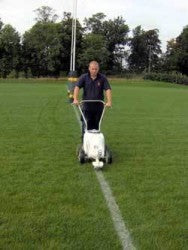
My other main concern is the fact that the OA club have chosen not to replace the one member of staff who they are expected to provide as part of the agreement with the school. It started with two full time. We are now restricted to 25 hours work per week on the club site. In summer they also employ a summer casual for the cricket.
This for me is a worry, especially as the popularity of the facility is increasing and therefore its usage. It is now widely used by the community.
Without the appropriate staffing and level of maintenance this part of the site will soon begin to deteriorate, which will definitely result in poor pitch quality over time. Once this decline starts the reputation of the Club will then suffer, the difference between the school site and the OAs is starting to show.
It epitomises a problem our sports turf industry always has to face. Many people just see and believe that natural grass pitches only ever require cutting and marking out. A fallacy that many Groundsmen what to see addressed and the record put straight.
I consider myself lucky, having such a dedicated well-trained staff that are not only multi-skilled but who compliment one another. Ideally it would be great if we could increase our staff levels, it does get rather hectic when staff are away, on leave or sick. I see seven fulltime staff as more of a realistic number required to maintain the high standards set, here at St Albans.
As for the future, I am very keen to continue the development of the site and look at realising its potential not only for the sporting activities but looking at the whole sustainability and biodiversity of the site in respect of wild life and fauna.
We have already begun work on extending the wild flower areas and looking to plant more native trees and shrubs. With regard to the sporting activities, the school would like to install another 'all weather' pitch facility, ideally it will be a water-based pitch for hockey use and possibly a 3G-rugby pitch for OAs rugby training pitch.
Plan of Playing fields

